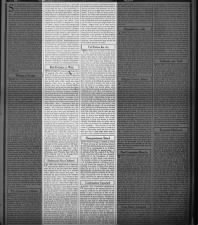 Redwoods Near Oakland
Lamson Sun, Dec 8, 1929 – Page 77 · Oakland Tribune (Oakland, California) · Newspapers.com
Redwoods Near Oakland
Lamson Sun, Dec 8, 1929 – Page 77 · Oakland Tribune (Oakland, California) · Newspapers.com
Redwoods Near Oakland
OF THE BIG REDWOODS in Redwood canyon behind Oakland, trees which fell under the ax in the days when their beauty was unappreciated, the diary of J. Lamson (1854) dwells with interest and regret. As forwarded by Albert Wheelan some excerpts are here quoted: Fuel was in demand in San Francisco in the fifties. Timber surrounding the town, scrub oak and other trees had succumbed to the ax. Yerba Buena and Angel Islands had contributed their growths to the woodsmen. The Contra Costa plains were cut off, and the woodsmen were cutting timber down the peninsula. Finally the trees in Redwood canyon commenced to yield a supply. Lumber was in demand and the big redwoods of the San Mateo and Santa Cruz hills were levied upon to supply this demand, as well as the redwoods on the Rancho Palos Colorados, as Redwood canyon was then called. The shipping point for this timber was San Antone, afterwards called Brooklyn, and now a part of Oakland. The diary of J. Lamson gives an interesting account of the work in the redwoods on the last mentioned rancho: "January 30th, 1854. On an excursion today I stopped on the way to see two trees felled. When the reader is told that I passed more than six months in the redwoods, and had seen trees fall around me almost every day, he would suppose that such scenes would lose their novelty for me. It is, however, a scene of no ordinary sublimity to behold one of these monster trees, nearly as high as the Bunker Hill Monument, fall to the ground, and it is a sight that I never tire of seeing. I speak of them as being nearly as high as the Bunker Hill Monument, because I have seen some of the largest and tallest trees, they having been felled, before I arrived here. But a comparison with the monument will give a better idea of their great height rather than, figures. Imagine then, one of them, such as have grown here, and such as are still standing in other forests - imagine one placed inside the monument and towering fifty or even seventy-five feet above it, and you will have a conception of the grandeur of those magnificent trees. The two trees whose fall I was about to witness stood side by side up a steep declivity. One of them had been cut off, and stood leaning against the other."["The Bunker Hill Monument was erected to commemorate the Battle of Bunker Hill, which was among the first major battles between British and Patriot forces in the American Revolutionary War, fought there June 17, 1775. The 221-foot (67 m) granite obelisk was erected between 1825 and 1843 in Charlestown, Massachusetts, with granite from nearby Quincy conveyed to the site via the purpose-built Granite Railway, followed by a trip by barge. There are 294 steps to the top." https://en.wikipedia.org/wiki/Bunker_Hill_Monument - MF]
Fall Before the Ax
"TWO MEN were at work on the latter tree. I seated myself on a stump at the foot of the hill and awaited the result. Presently a sharp snap or crackle announced that the tree was yielding to the efforts of the ax-men, and they stopped and looked up. It stood, however, and they continued to ply their axes. Soon there came another sharp crackle, and the two trees commenced to sway in the direction the ax-men had intended. They now retreated to a secure place, while the trees, moving slowly and majestically, at first, but with an accelerated motion, came sweeping down, accompanied with a loud and protracted crash, as the fibers of the uncut portions were torn asunder, and striking the ground with a force that made it tremble, and with a noise like the report of a booming cannon. Each tree was broken into several pieces, which came rolling like mighty giants down the hill, tumbling over each other, and strewing the ground with large fragments torn from their sides and ends while every branch was stripped from the trunks. They landed at last at the foot of the hill, and within a rod of the stump on which I sat, and sent forward a thick and suffocating cloud of dust from which I hastened to make my escape. 'Ah! we would go a great many miles in Massachusetts to see such a sight as this,' said one of the ax-men, a young man from that state, 'but we never see anything like it there.' There came an end to the trees. In three or four months where a deep, dense forest had once existed, with, a busy population at work, had become a solitude. Industry bad swept away the forest, and as the timber grew scarcer the woodsmen sought other locations." This account of the redwoods of Alameda county may be noted as a lesson. What price would the City of Oakland pay now if these giant trees could be restored to their pristine beauty and dignity?[This story is told in the section Felling Trees in the Redwoods, from Joseph Lamson's Round Cape Horn. VOYAGE OF THE Passenger-Ship James W. Paige, From Maine to California in the Year 1852. book, published 1878. - MF]
Hi Morgan , How are you dealing with the fires ?
ReplyDeleteHi, fires are far from here. We have bad smoke. N95 mask for hikes.
ReplyDelete